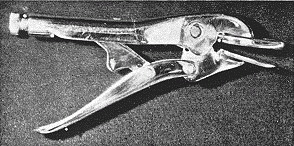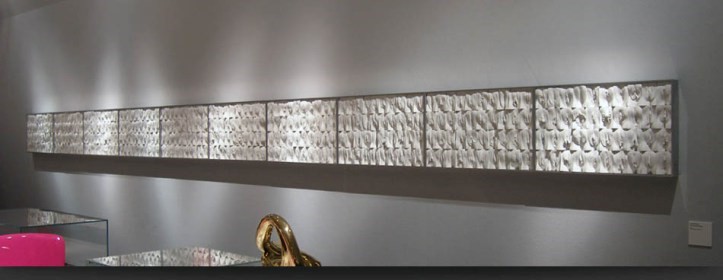The SHADOW of FGM in the USA: Female Circumcision, Clitoridectomy, and American Culture
By Sarah Rodriguez, Nursingclio.org, January 8, 2015. Sarah
Rodriguez is a lecturer in Medical Humanities and Bioethics in the Feinberg
School of Medicine and a lecturer in Global Health Studies in the Weinberg
College of Arts and Sciences at Northwestern University. Sarah’s area of
research is women’s reproductive and sexual health. You can find out more about
her at: http://www.sarahbrodriguez.com
Rodriguez is a lecturer in Medical Humanities and Bioethics in the Feinberg
School of Medicine and a lecturer in Global Health Studies in the Weinberg
College of Arts and Sciences at Northwestern University. Sarah’s area of
research is women’s reproductive and sexual health. You can find out more about
her at: http://www.sarahbrodriguez.com

In the
United States, female circumcision (the removal of the clitoral hood) and
clitoridectomy (the removal of the external nub of the clitoris) are nearly
always regarded as practices that happen someplace else. When their
presence within the United States is acknowledged, these procedures are
positioned as having come from the outside, as originating with immigrants from parts of the world
where they are performed as an “initiation rite” for young
girls. Indeed, termed FGM/C (female genital mutilation/cutting) by the WHO
and USAID, the practices are deemed to be cultural and performed for
“non-medical reasons.”[1]
United States, female circumcision (the removal of the clitoral hood) and
clitoridectomy (the removal of the external nub of the clitoris) are nearly
always regarded as practices that happen someplace else. When their
presence within the United States is acknowledged, these procedures are
positioned as having come from the outside, as originating with immigrants from parts of the world
where they are performed as an “initiation rite” for young
girls. Indeed, termed FGM/C (female genital mutilation/cutting) by the WHO
and USAID, the practices are deemed to be cultural and performed for
“non-medical reasons.”[1]
There are a
couple of problems with this framing of FGM/C. First, labeling these procedures
as cultural and not medical serves not only to invalidate them, but it also
suggests that if they were performed for medical reasons, then the procedures
would be acceptable. Secondly, framing FGM/C as performed for cultural but not
medical reasons implies that medical reasons can be separated from their
cultural context. Finally, this framing fails to account for the practice of
the two procedures that fall under the broad category of FGM/C — female
circumcision and clitoridectomy — that have been performed in the United States
for medical reasons.
couple of problems with this framing of FGM/C. First, labeling these procedures
as cultural and not medical serves not only to invalidate them, but it also
suggests that if they were performed for medical reasons, then the procedures
would be acceptable. Secondly, framing FGM/C as performed for cultural but not
medical reasons implies that medical reasons can be separated from their
cultural context. Finally, this framing fails to account for the practice of
the two procedures that fall under the broad category of FGM/C — female
circumcision and clitoridectomy — that have been performed in the United States
for medical reasons.

Instrument
designed by W. G. Rathmann to aid in female circumcision. In a 1959 article advocating female circumcision, he
suggested that it might help some husbands by making the clitoris “easier to
find.”
designed by W. G. Rathmann to aid in female circumcision. In a 1959 article advocating female circumcision, he
suggested that it might help some husbands by making the clitoris “easier to
find.”
Medicine is
practiced within a culture, and medical reasons are both influenced by, and
influence, the culture in which those reasons are formed. As I was writing this
blog, I also was working on a lecture for first-year medical students on
cholera in the 19th century, and I wanted to situate this disease in its
cultural context. I pulled Charles Rosenberg’s The Cholera Years off
my shelf, and, reading through it, landed on his recollections of his
undergraduate course. In that course, “The History and Geography of Disease,”
Rosenberg recalled learning that disease was “defined and framed in ways
appropriate both to the clinical manifestations of a specific disease and to
the more general contours and needs of the culture in which it appeared.”[2] I
decided to include this in my cholera lecture to introduce my students to the
ways in which disease is both a physiological and a social entity. But
rereading this quotation, I also was struck by how it could be used as a way to
frame the history of female circumcision and clitoridectomy in the United
States.
practiced within a culture, and medical reasons are both influenced by, and
influence, the culture in which those reasons are formed. As I was writing this
blog, I also was working on a lecture for first-year medical students on
cholera in the 19th century, and I wanted to situate this disease in its
cultural context. I pulled Charles Rosenberg’s The Cholera Years off
my shelf, and, reading through it, landed on his recollections of his
undergraduate course. In that course, “The History and Geography of Disease,”
Rosenberg recalled learning that disease was “defined and framed in ways
appropriate both to the clinical manifestations of a specific disease and to
the more general contours and needs of the culture in which it appeared.”[2] I
decided to include this in my cholera lecture to introduce my students to the
ways in which disease is both a physiological and a social entity. But
rereading this quotation, I also was struck by how it could be used as a way to
frame the history of female circumcision and clitoridectomy in the United
States.
As I discuss
in my recent book on the history of female circumcision and
clitoridectomy in America, many Americans who condemn the practice
of FGM/C elsewhere in the world don’t realize that some physicians used
clitoridectomy and female circumcision as therapies here in the
United States, since at least the mid-19th century. The
procedures were used until at least the 1960s as medical treatments
for masturbation in infants, girls, and women. In addition, female
circumcision has been used continually since at least the
1890s as a therapy to enable an adult woman to orgasm during penetrative,
heterosexual sex. The therapeutic use of female circumcision and clitoridectomy
were based within a medical understanding of the clitoris as a, if not the,
principal sexual organ for women. But the surgeries were also based within a
cultural understanding of what constituted normative and healthy female sexual behavior
for white, middle class women: heterosexual and penetrative (and more often
than not, married). If a 10-year-old girl masturbated or a 22-year-old woman
failed to orgasm with her husband, some believed the basis of this “abnormal”
behavior lay in an “abnormal” condition of the clitoris. Some physicians thus
corrected the condition by circumcising or removing the organ.
in my recent book on the history of female circumcision and
clitoridectomy in America, many Americans who condemn the practice
of FGM/C elsewhere in the world don’t realize that some physicians used
clitoridectomy and female circumcision as therapies here in the
United States, since at least the mid-19th century. The
procedures were used until at least the 1960s as medical treatments
for masturbation in infants, girls, and women. In addition, female
circumcision has been used continually since at least the
1890s as a therapy to enable an adult woman to orgasm during penetrative,
heterosexual sex. The therapeutic use of female circumcision and clitoridectomy
were based within a medical understanding of the clitoris as a, if not the,
principal sexual organ for women. But the surgeries were also based within a
cultural understanding of what constituted normative and healthy female sexual behavior
for white, middle class women: heterosexual and penetrative (and more often
than not, married). If a 10-year-old girl masturbated or a 22-year-old woman
failed to orgasm with her husband, some believed the basis of this “abnormal”
behavior lay in an “abnormal” condition of the clitoris. Some physicians thus
corrected the condition by circumcising or removing the organ.

“The Great Wall of Vagina,”
by Jamie McCartney. Intended to push back against the idea of surgically
“perfecting” female sexuality and biology. (Triennale di Milano design museum
in Milan, March 2013)
by Jamie McCartney. Intended to push back against the idea of surgically
“perfecting” female sexuality and biology. (Triennale di Milano design museum
in Milan, March 2013)
The medical
understanding of women’s bodies existed within a cultural context
that posited a narrow definition of healthy sexual behavior for females. Female
circumcision and clitoridectomy in the United States were, to paraphrase
Rosenberg, therapies “defined and framed in ways appropriate to both the
clinical” (an understanding of the clitoris as a sexual organ) and “the more
general contours and needs of the culture” (a narrow understanding of normative
female sexual behavior). The medical reasons for the use of female circumcision
and clitoridectomy were embedded within American cultural ideas regarding
“appropriate” female sexuality. To put it simply: these medical procedures were
part of American culture.
understanding of women’s bodies existed within a cultural context
that posited a narrow definition of healthy sexual behavior for females. Female
circumcision and clitoridectomy in the United States were, to paraphrase
Rosenberg, therapies “defined and framed in ways appropriate to both the
clinical” (an understanding of the clitoris as a sexual organ) and “the more
general contours and needs of the culture” (a narrow understanding of normative
female sexual behavior). The medical reasons for the use of female circumcision
and clitoridectomy were embedded within American cultural ideas regarding
“appropriate” female sexuality. To put it simply: these medical procedures were
part of American culture.
Dr.
Rosenberg, if you are reading this, I hope you are not uncomfortable by my use
of your work on cholera as a point of reference to illustrate how female
circumcision and clitoridectomy were framed by medical ideas of the female body
and cultural ideas of acceptable female sexual behavior. That said, I hope that
knowing the American history of these medical practices leads to some
productive, if possibly uncomfortable, discussions among Americans generally,
and more specifically among those at organizations such as USAID and the WHO,
as they consider the labeling of FGM/C as cultural practices done for
non-medical reasons.
Rosenberg, if you are reading this, I hope you are not uncomfortable by my use
of your work on cholera as a point of reference to illustrate how female
circumcision and clitoridectomy were framed by medical ideas of the female body
and cultural ideas of acceptable female sexual behavior. That said, I hope that
knowing the American history of these medical practices leads to some
productive, if possibly uncomfortable, discussions among Americans generally,
and more specifically among those at organizations such as USAID and the WHO,
as they consider the labeling of FGM/C as cultural practices done for
non-medical reasons.
Notes
[1] USAID, “Female Genital Mutilation/Cutting:
United States Government’s Response,” updated July 21, 2014.
United States Government’s Response,” updated July 21, 2014.
[2] Charles Rosenberg, The
Cholera Years: The United States in 1832, 1849, and 1866 (Chicago: The
University of Chicago Press, 1987): 235.
Cholera Years: The United States in 1832, 1849, and 1866 (Chicago: The
University of Chicago Press, 1987): 235.
Feature
image: The Hospital (Spyros Papaspyropoulos/Flickr CC BY-NC-ND)
image: The Hospital (Spyros Papaspyropoulos/Flickr CC BY-NC-ND)
Suggested
readings:
readings:
Kirsten
Bell, “Genital Cutting and Western Discourses on Sexuality,” Medical
Anthropology Quarterly 19 (2005): 125-148.
Bell, “Genital Cutting and Western Discourses on Sexuality,” Medical
Anthropology Quarterly 19 (2005): 125-148.
Ylva Herlund
and Bettina Shell-Duncan, eds. Transcultural Bodies: Female Genital Cutting
in Global Context (Rutgers University Press, 2007).
and Bettina Shell-Duncan, eds. Transcultural Bodies: Female Genital Cutting
in Global Context (Rutgers University Press, 2007).
Birgitta
Essen and Sara Johnsdotter, “Female Genital Mutilation in the West: Traditional
Circumcision versus Genital Cosmetic Surgery,” Acta Obstetrica et
Gynecologica Scandinavica 83 (2004): 611-613.
Essen and Sara Johnsdotter, “Female Genital Mutilation in the West: Traditional
Circumcision versus Genital Cosmetic Surgery,” Acta Obstetrica et
Gynecologica Scandinavica 83 (2004): 611-613.
Marge Berer,
“Labia Reduction for Non-Therapeutic Reasons vs. Female Genital Mutilation:
Contradictions in Law and Practice in Britain,” Reproductive Health Matters
18 (2010): 106-110.
“Labia Reduction for Non-Therapeutic Reasons vs. Female Genital Mutilation:
Contradictions in Law and Practice in Britain,” Reproductive Health Matters
18 (2010): 106-110.


